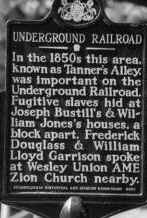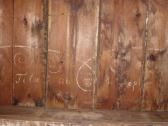|

|
to
seek
freedom...
the Underground
Railroad
in Central Pennsylvania
|
|
UGRR
markings?
|
|
Possible
Underground Railroad
Markings discovered in
Chester County |
Below are two pictures of markings discovered during the
renovation of a circa-1803 farmhouse in Chester County. The owner,
upon the advice of a friend with some knowledge of nineteenth century
culture who suggested that they may be in some way related to
Underground Railroad activity, sent pictures of the markings to us for
help. We have examined the pictures and are not sure what they
represent, but we are intrigued by them, and by certain clues from the
words.
 
Please click the images above for large versions. |
|
Some
intriguing clues:
"Fila"
|
The sentence written below the design says "Fila bite the
people." There is a small mark between the words "Fila"
and "bite," but it does not appear to be either a single
letter or a small word. The writer seems to have taken care not to
write over the gutter between the boards, but has spaced the words
carefully around the gutter, with the exception of the final letter of the
word "people." From the overall composition, it also
appears that the sentence was added after the looping design was drawn.
We believe that the work "Fila" refers to the canine breed
Fila Brasileiro (Brazilian Mastiff), a fierce and fearless breed of dog first bred
in Brazil. It was used in that country to guard livestock, hunt jaguars,
jungle warfare, guard plantations, and to track and capture fugitive slaves.
Fila Brasilieiro is a mix of bloodhound and English bulldog, by some
accounts, and is a very large and powerful animal.
Filas are not native to the United States and are even today quite rare here
because of their temperament. They were only bred in this country recently
(within the last twenty years) and even today most breeding stock comes from
Brazil. Filas are very loyal to family, but have an intense distrust of
strangers, and will bite and attack. Filas are even known to keep farmhands
from entering farms in Brazil. For these reasons it is very unlikely that a
Fila was a "farm dog" on this Chester County farm.
However it is well documented that slave owners in the United States used dogs to
track and capture runaway slaves. The bloodhound was the most frequently
used dog, not only because of its excellent tracking ability, but because it
would attack and bite the slaves when it captured them. This may seem
contrary to common sense, as we would think a slave holder would not want to
harm his property, but history shows us that quite the opposite is true.
Slaves captured after running away were usually given brutal punishments,
including beatings, brandings, maiming, and whippings. It seems that slave
holders considered this the cost of making an example of runaway slaves.
The Fila, though, was trained to hold its prey without seriously harming
it, thus making it a better choice than bloodhounds for professional
slave-trackers-- men who made their living tracking and
capturing slaves.
There existed, in the south, agencies that specialized in "negro dogs," or
dogs specially trained to hunt fugitive slaves. These dogs were sold to
slave holders and slave-trackers. While we know that these breeders did not breed Filas, it
is possible that they imported some of these dogs for sale to their clients.
Filas are known to have existed, as imported dogs belonging to the upper
class, in Great Britain during this period. Given the close relationship
between southern planters and British society, and the business relationship
with Brazilian planters, it is not unlikely that the Fila could have made an
appearance on southern plantations. Remember that Brazil was the
destination of choice for southerners who fled the south with their slaves
after the surrender of the Confederacy in 1865. Could this word,
therefore, refer to an encounter with a Fila used as a tracking dog?
Next page
|
|
some
links to Fila Brasileiro
Internet sites
|
Photographs of Filas and stories from
owners
Was the "Hound of the
Baskervilles" a Fila?
Interesting essay that examines the possibility that this fictional
hound was a Fila or mastiff/bloodhound/bulldog cross. It also
looks at the use of such dogs for slave-hunting.
|
|
Your
comments
|
We would like to obtain additional information regarding these markings,
to prove or disprove their significance to Underground Railroad history.
If you have information, comments or observations that you think are
useful in helping to identify the markings, please email your comments
to .
|
|
Documentation
of "Negro-Dogs"
and the breeding of dogs for
slave-hunting in the U.S.
|
Blassingame, John W., editor. Slave Testimony. Baton
Rouge: Louisiana State University Press, 1977, p. 222. (On
slave catchers: "This young man had obtained the honourable
epithet of the 'Niggerhunter,' from his success in tracking the poor
runaways, and was often requested to undertake the recapture by
neighbouring planters, for which purpose he frequently employed
blood-hounds." The text elsewhere makes numerous references
to bloodhounds and bulldogs used in tracking slaves.)
Chesson, F. W. Secret Wires, Grounded Connections.
Internet document. http://pages.cthome.net/fwc/POW.HTM
Accessed December 8, 2002. (Mentions the use of "Negro
Dogs" to track Blacks attached to a Union telegraph
"wiretapping" party during the Civil War. Note: link now invalid)
Franklin, John Hope and Loren Schweninger. Runaway Slaves:
Rebels on the Plantation. New York: Oxford University
Press, 1999. p. 160-164. (Franklin does not mention Filas by name, but
notes "presidential candidate Zachary Taylor imported dogs from the
Caribbean trained to chase slaves. the dogs were fierce
hunters." In South Carolina, Franklin documents a man named
Simpson who owned "an uncommon and extraordinary dog for
trailing."
Frederick Douglass Paper. Rochester, N.Y., March 11, 1853.
("NEGRO DOGS. - The undersigned would respectfully inform the citizens of Ouachita and adjacent parishes, that he has located about 2 1-2 miles east of John White's, on the road leading from Monroe to Bastrop, and that he has a fine pack of dogs for catching negroes. Persons wishing negroes caught will do well to give him a call. He can always be found at his stand when not engaged in hunting, and even then information of his whereabouts can always be had of some one on the premises. TERMS - Five dollars per day and found, when there is no track pointed out. When the track is shown, twenty-five dollars will be charged for catching the negro. M.C. GOFF.
MONROE, La., Feb. 17, 1852.") From Accessible Archives, at www.accessible.com.
There are several similar advertisements in the archives.
Library of Congress. A. Harry Williams Interview.
Internet document. http://memory.loc.gov/mss/wpalh3/37/3706/37060203.htm
(link no longer active),
Accessed December 8, 2002. ("One of his neighbors, Henry Williams owned a few negroes. Cox and Williams trained the dogs by having them run one of these
negroes.") The Slave Narratives are accessible by
clicking here.
San Jose State University. The Diary of Bennet H. Barrow,
Louisiana Slaveowner. Internet document. http://www.sjsu.edu/faculty/watkins/barrow.htm
Accessed December 8, 2002. (Numerous references to "Negro
Hunters" arriving with "Negro Dogs" to trail two runaway
slaves. Note: link no longer active.)
Born in Slavery: Slave Narratives from the Federal Writers' Project, 1936-1938
Library of Congress, Manuscript Division.
Maryland Narratives, Volume VIII
Page Harris, ex-slave, typewritten narrative recalls the breeding and training
of Negro-tracking dogs in Maryland--two images:
025022.gif
026023.gif
|
Submit Comments |
Afrolumens.org Main Page
|
